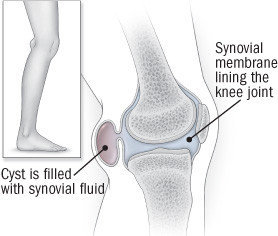Ask the doctor: How do you treat a Baker's cyst?
Q. I have a Baker's cyst in my right knee. It has been drained twice and recurred. Are there any other treatments for it?
A. Your situation is fairly common. A Baker's cyst (also called a popliteal cyst) is a fluid-filled sac that can develop in the popliteal space, the hollow at the back of the knee joint. It's named for William Morrant Baker, a 19th-century surgeon who first described the condition. The cyst is filled with synovial fluid, a viscous material that lubricates the knee joint, reducing friction among the components of the joint and allowing the knee to flex and extend freely. There are several ways to treat a Baker's cyst, but it will often recur if the underlying cause hasn't been addressed.
A Baker's cyst may occur as a result of an injury to the knee, such as a tear in a meniscus, or damage to the cartilage from conditions such as rheumatoid arthritis or osteoarthritis. These conditions may cause the synovial cells lining the knee joint to produce excess fluid. If the fluid bulges into the popliteal space, a cyst can develop (see the illustration). The excess fluid can also cause the whole knee to become swollen.
|
Baker's cyst
A Baker's cyst forms when excess synovial fluid bulges into the hollow at the back of the knee joint. |
A Baker's cyst is often found incidentally during a physical exam or an ultrasound performed for other reasons. It may cause no symptoms at all or just a bulge at the back of the knee, but it can also cause pain, swelling, and joint stiffness. Sometimes the bulge is so large that it's hard to fully bend or straighten the leg.
Baker's cysts aren't dangerous and they may go away on their own. But occasionally they burst, and if that happens, synovial fluid can leak into the calf below, causing pain, swelling, and reddening. These symptoms resemble those produced by a blood clot in the calf, deep vein thrombosis (DVT), a serious condition that requires immediate treatment. That's why it's important to find the source of the problem right away. (A painless Doppler ultrasound of the calf can rule out DVT.)
If a Baker's cyst causes discomfort or interferes with normal activities, there are several things you can do. To bring down swelling, apply a cold pack to the area, or use a compression wrap. To reduce inflammation, take an over-the-counter nonsteroidal anti-inflammatory drug such as ibuprofen (Motrin, Advil, others) or naproxen (Aleve, others). Because stress on the knee joint can increase inflammation, rest your leg, and keep it elevated whenever you can. When you're up and about, use a cane or crutch.
If cyst is related to knee arthritis, doctors often do a cortisone injection into the knee to reduce inflammation. Sometimes, a Baker's cyst needs to be drained by a doctor experienced in this procedure..
If, despite these treatments, the cyst recurs and remains troublesome, MRI imaging may be done to detect an underlying meniscal tear or other possible cause of increased joint fluid and cyst formation. Rarely, the cyst is surgically removed. While you're considering your options, protect your knee by doing gentle (non-weight-bearing) range-of-motion and muscle-strengthening exercises. Talk to your doctor about a referral to physical therapy. You may need to scale back on activities like jogging, tennis, or golf. And try to lower the stress on your knee by maintaining a healthy body weight.
About the Author

Celeste Robb-Nicholson, MD, Contributor
Disclaimer:
As a service to our readers, Harvard Health Publishing provides access to our library of archived content. Please note the date of last review or update on all articles.
No content on this site, regardless of date, should ever be used as a substitute for direct medical advice from your doctor or other qualified clinician.

















